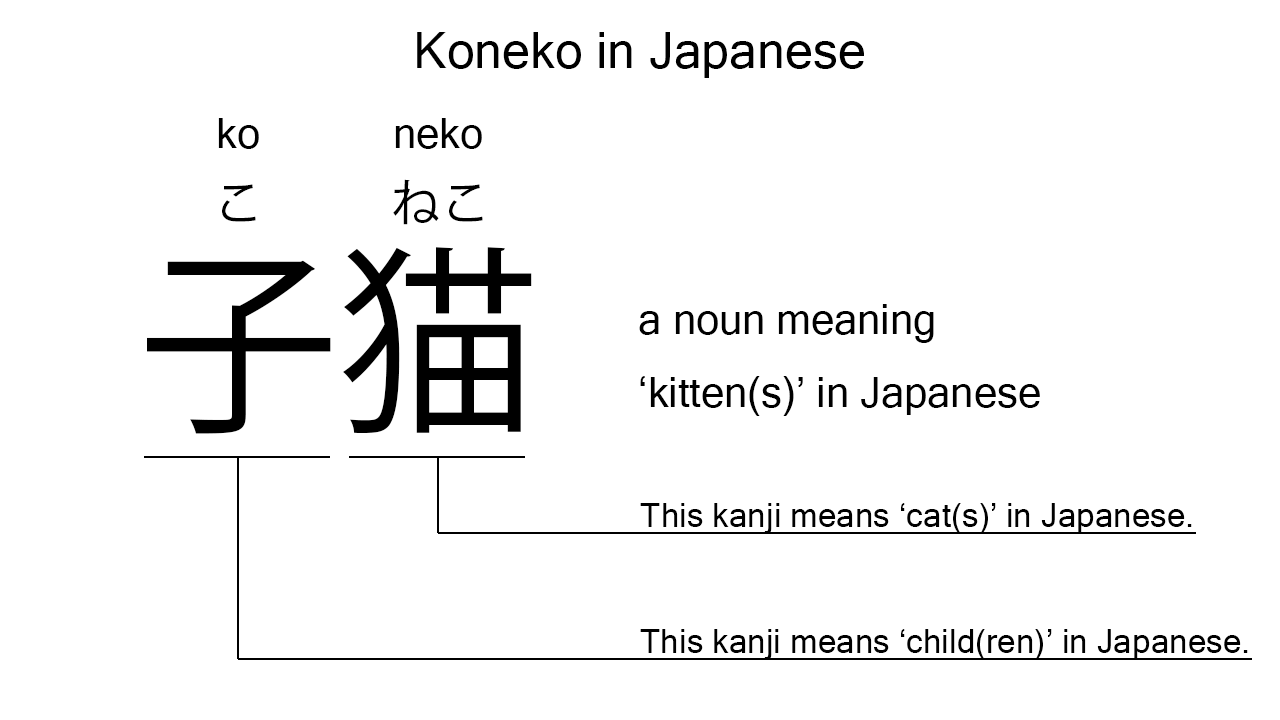What does “koneko” mean in Japanese?
Native speakers use koneko to mean a ‘kitten’ in Japanese. Perhaps, some Japanese learners know this word as it is sometimes used in Japanese movies, songs, novels, manga, anime, and the like. In this blog post, however, I’m explaining this word in detail based on its kanji expression. And also, I’m explaining how to use it through example sentences. My explanations would help Japanese learners understand koneko more clearly. Then, let’s get started!
Contents
Definition and meaning of “koneko”
Let me start with the definition and meaning of koneko.
- koneko – 子猫 (こねこ) : a noun meaning a ‘kitten’ in Japanese. This can also work as plural. Learn more about Japanese plural.
Native speakers use this noun to refer to a very young cat or cats in Japanese.
The definition and meaning are simple and clear. To understand this noun more clearly, however, let me explain its kanji characters in detail, one by one.
Koneko in kanji
The kanji expression of koneko consists of the following two kanji characters:
- 子 : a kanji character used to mean a ‘child’ or ‘kid’ in Japanese.
- 猫 : a kanji character used to mean a ‘cat’ in Japanese.
From these two kanji characters, we can understand that koneko literally means a ‘child cat’ in Japanese. This literal interpretation is very close to the actual meaning.

When we meet new kanji expressions, we should check their kanji characters in detail to understand their meanings clearly and deeply. In many cases, kanji characters tell us a lot about the meanings of the expressions they form. Actually, here, we could get the better understanding of koneko through the detailed kanji check above.
So far, I’ve explained the definition and meaning of koneko together with its kanji characters. Then, let me explain how to use it through the example sentences below.
How to say “kitten” in Japanese
watashi wa michi de koneko wo mitsuke ta – 私は道で子猫を見つけた (わたしはみちでこねこをみつけた)
I found a kitten on the street.
Below are the new words used in the example sentence.
- watashi – 私 (わたし) : a pronoun meaning ‘I’ in Japanese.
- wa – は : a binding particle working as a case marker or topic marker. In the example, this works after watashi to make the subject in the sentence.
- michi – 道 (みち) : a noun meaning a ‘street’, ‘road’, or such in Japanese. This can also work as plural.
- de – で : a case particle used to say where someone does something. In the example, this is used after michi to say where the speaker found the kitten.
- wo – を : a case particle used to make the object word in a sentence. In the example, this is used after koneko to make the object in the sentence.
- mitsuke – 見つけ (みつけ) : one conjugation of the verb, mitsukeru, which means ‘to find’ in Japanese. In the example, it has been conjugated for the better connection with its following word.
- ta – た : an auxiliary verb used after a verb, adjective, or auxiliary verb to make its past tense form. In the example, this is used after mitsuke to make its past tense form, mitsuke ta.
This is a typical usage of koneko. In this example, it works together with the case particle, wo, to become the object in the sentence.
Another example of “koneko”
koneko ga totemo kawaii desu – 子猫がとても可愛いです (こねこがとてもかわいいです)
The kitten is very cute.
Below are the new words used in the example sentence.
- ga – が : a case particle used to make the subject word or the object word in a sentence. In the example, this is used after koneko to make the subject in the sentence.
- totemo – とても : an adverb of degree meaning ‘very’, ‘much’, ‘so’, or such in Japanese. In the example, this works in front of kawaii to emphasize its meaning.
- kawaii – 可愛い (かわいい) : an i-adjective meaning ‘cute’ in Japanese.
- desu – です : an auxiliary verb used after a noun or adjective to make it polite. In the example, this is used after kawaii to make it sound polite.
This is another example of koneko. In this example, it works together with the case particle, ga, to become the subject in the sentence. When we want to mean a ‘kitten’ or ‘kittens’ in Japanese, anyway, koneko is always a very good option.
Summary
In this blog post, I’ve explained the definition and meaning of koneko in detail based on its kanji expression. And also, I’ve explained how to use it through the example sentences. Let me summarize them as follows.
- koneko – 子猫 (こねこ) : a noun meaning a ‘kitten’ in Japanese. This can also work as plural. These two kanji characters literally mean a ‘child cat’ in Japanese. This literal interpretation is very close to the actual meaning. When we want to refer to a very young cat or cats in Japanese, this noun is always a very good option.
Hope my explanations are understandable and helpful for Japanese learners.
Leave a Reply